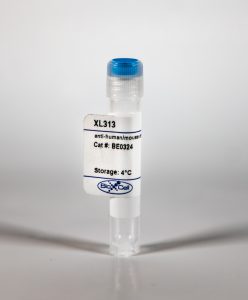InVivoMAb anti-human/mouse denatured collagen type-I (RGD motif)
| Clone | XL313 | ||||||||||||
|---|---|---|---|---|---|---|---|---|---|---|---|---|---|
| Catalog # | BE0324 | ||||||||||||
| Category | InVivoMab Antibodies | ||||||||||||
| Price |
|
The XL313 monoclonal antibody reacts with denatured human and mouse collagen type-I but not native collagen type-I. The antibody reacts with the RGD motif. Collagen is a fibrous multi-chain triple helical protein that exists in numerous forms. Collagen type-I is the most abundant collagen type in the extracellular matrix. Collagen type-I, type-III, collagen type-IV and collagen type-V have been shown to be associated with all pre-existing blood vessels in vivo. Denaturation of the native three-dimensional structure of collagen is thought to expose cryptic regulatory regions that control angiogenesis. The XL313 antibody has been shown to inhibit angiogenesis in chick embryos and enhance the anti-tumor activity of anti-PD-L1 therapy in vivo. XL313 administration has also been shown to inhibit Lewis lung carcinoma tumor growth in C57BL/6 mice (shown in US Patent No: 7588760B2).
| Isotype | Mouse IgG1, κ |
| Immunogen | Synthetic RGD containing human collagen peptides |
| Reported Applications |
|
| Formulation |
|
| Endotoxin |
|
| Purity |
|
| Sterility | 0.2 μM filtered |
| Production | Purified from tissue culture supernatant in an animal free facility |
| Purification | Protein G |
| RRID | AB_2819051 |
| Molecular Weight | 150 kDa |
| Storage | The antibody solution should be stored at the stock concentration at 4°C. Do not freeze. |
InVivoMAb anti-human/mouse denatured collagen type-I (RGD motif) (Clone: XL313)
Ames, J. J., et al. (2016). "Identification of an Endogenously Generated Cryptic Collagen Epitope (XL313) That May Selectively Regulate Angiogenesis by an Integrin Yes-associated Protein (YAP) Mechano-transduction Pathway." J Biol Chem 291(6): 2731-2750. PubMed
Extracellular matrix (ECM) remodeling regulates angiogenesis. However, the precise mechanisms by which structural changes in ECM proteins contribute to angiogenesis are not fully understood. Integrins are molecules with the ability to detect compositional and structural changes within the ECM and integrate this information into a network of signaling circuits that coordinate context-dependent cell behavior. The role of integrin alphavbeta3 in angiogenesis is complex, as evidence exists for both positive and negative functions. The precise downstream signaling events initiated by alphavbeta3 may depend on the molecular characteristics of its ligands. Here, we identified an RGD-containing cryptic collagen epitope that is generated in vivo. Surprisingly, rather than inhibiting alphavbeta3 signaling, this collagen epitope promoted alphavbeta3 activation and stimulated angiogenesis and inflammation. An antibody directed to this RGDKGE epitope but not other RGD collagen epitopes inhibited angiogenesis and inflammation in vivo. The selective ability of this RGD epitope to promote angiogenesis and inflammation depends in part on its flanking KGE motif. Interestingly, a subset of macrophages may represent a physiologically relevant source of this collagen epitope. Here, we define an endothelial cell mechano-signaling pathway in which a cryptic collagen epitope activates alphavbeta3 leading to an Src and p38 MAPK-dependent cascade that leads to nuclear accumulation of Yes-associated protein (YAP) and stimulation of endothelial cell growth. Collectively, our findings not only provide evidence for a novel mechano-signaling pathway, but also define a possible therapeutic strategy to control alphavbeta3 signaling by targeting a pro-angiogenic and inflammatory ligand of alphavbeta3 rather than the receptor itself.






